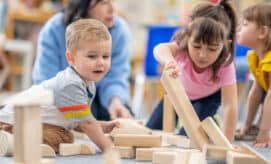Rhyming is very popular in children’s books. Many stories include fun, rhythmic language that can almost make the book feel like one long song or poem. Children enjoy listening to books that use rhyming language! Rhyming stories are often read in a sing-song style that makes these books engaging while also helping children develop skills in language and early literacy. As children listen to books with rhyme, they are learning about similarities of sounds in spoken words.
Phonological Awareness
Kelli Johnson, an educational speech-language pathologist and writer for Understood, explains “People often think that reading begins with learning to sound out letters. Most young kids are getting ready to read, however, long before they learn that letters stand for sounds. Reading actually starts with kids tuning in to the sounds of spoken words. That’s where phonological awareness comes in. Phonological awareness is a skill that allows kids to recognize and work with the sounds of spoken language.”
Put simply, phonological awareness refers to children’s ability to understand that the words we speak can be broken down and taken apart. When children are younger, this skill is really a simple awareness. But, as children get older, this skill progresses into an ability to break words apart into syllables and by single sounds.
For a more detailed look at phonological awareness, view the video below:
Phonological Awareness and Rhyming
Phonological awareness is often picked up by children as a result of being in a language-rich environment. When children listen to rhyming stories or songs, it is helping them to build these skills.
Research conducted by The Center for Early Literacy at the Orelena Hawks Puckett Institute evaluated the relationship between children’s nursery rhyme abilities (experiences, awareness, and knowledge) and their literacy skills development. Children’s experiences with nursery rhymes were found to positively impact children’s early phonological and print related skills. The results showed that sharing nursery rhymes with children during early childhood can support literacy-related abilities later on.
According to Reading Rockets, as children enjoy reading and reciting learned rhyming words (such as in familiar stories or nursery rhymes), they are demonstrating a responsiveness to rhyme and alliteration. This leads to later literacy skills, such as syllable awareness and an ability to recognize and produce rhyming words.
Supporting Development
PBS Kids encourages reading rhyming books with children to support their skills in early literacy. On their site, they share a list of favorite rhyming books that can be found here. The list includes classics such as Chicka Chicka Boom Boom, Goodnight Moon, and Madeline as well as new books to share with the children in your care.
Another fun way to help support the development of these skills is by using children’s names in rhymes. A Fun Day shares that children’s names are important to them, which makes them a great resource for teaching. Simple word plays using children’s names and the names of their peers is a great way to introduce rhyme. This can be done by calling kids rhyming versions of their names such as “Silly Billy” or “Great Nate.”
Printable Resources
If you are interested in downloading some printables to have handy in your classroom or to share with parents, view our list of free available downloads below. To incorporate these songs and rhymes into your classroom curriculum, they can be shared with children during circle time or morning meeting.





